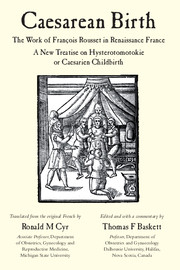 Caesarean Birth
Caesarean Birth Book contents
- Frontmatter
- Contents
- Acknowledgements
- Preface
- Translator's introduction
- François Rousset and the first text on caesarean section: a commentary by Thomas F Baskett
- A New Treatise on Hysterotomotokie or Caesarien Childbirth
- Sonnet
- Dedication
- Preface to the reader
- Part 1 Definition of caesarean childbirth
- Part 2 Second proof: logic (reason)
- Part 3 Third justification: expert opinion
- Part 4 Examples documenting other worse dangers from similar operations that are not caesarean
- Part 5 Other more popular justifications
- Part 6 On the fertility that remains after caesarean section
- A short guide to surgeons on the technique of caesarean
- Approbation
- Copyright
- Appendix 1 Summary of 16th century French history
- Appendix 2 Renée de France (1510–1575), Duchess of Ferrara, Chartres, Montargis and Nemours
- Appendix 3 Jacques de Savoie-Nemours (1531–1585), Duc de Nemours and Genevois
- Index
Part 1 - Definition of caesarean childbirth
Published online by Cambridge University Press: 05 June 2014
- Frontmatter
- Contents
- Acknowledgements
- Preface
- Translator's introduction
- François Rousset and the first text on caesarean section: a commentary by Thomas F Baskett
- A New Treatise on Hysterotomotokie or Caesarien Childbirth
- Sonnet
- Dedication
- Preface to the reader
- Part 1 Definition of caesarean childbirth
- Part 2 Second proof: logic (reason)
- Part 3 Third justification: expert opinion
- Part 4 Examples documenting other worse dangers from similar operations that are not caesarean
- Part 5 Other more popular justifications
- Part 6 On the fertility that remains after caesarean section
- A short guide to surgeons on the technique of caesarean
- Approbation
- Copyright
- Appendix 1 Summary of 16th century French history
- Appendix 2 Renée de France (1510–1575), Duchess of Ferrara, Chartres, Montargis and Nemours
- Appendix 3 Jacques de Savoie-Nemours (1531–1585), Duc de Nemours and Genevois
- Index
Summary
By Caesarean, we mean the skilful extraction of a child through a sufficiently large incision performed in the mother's anterior abdominal wall and uterus; this is accomplished without jeopardising the life of either mother or child (unless they have already suffered harm from some other cause), or even compromising the mother's ability to bear children in the future. We speak here of a child still alive in its mother's womb.
Caesarean also refers to the extraction in like manner of a child already dead, if it cannot be delivered using easier or more common methods, and it becomes apparent that the mother will otherwise die undelivered. Women of every social class all too frequently perish needlessly and miserably from a ruptured uterus.
As for the delivery of living children from the abdomen of a dead mother (who might herself have been saved by the caesarean), about which much has been unnecessarily written by both ancient and modern authors, there is not much skill to that, and I don't intend to discuss it here—even if this operation was named ‘Caesarean’ after the first of the Caesars (Scipio Africanus), who was thus brought into the world. We hope nonetheless that, with the help of God, this operation will have a better outcome—namely, survival of the mother—than was the case at Scipio's birth, according to the Latin poet Silius Italicus.
- Type
- Chapter
- Information
- Caesarean BirthThe Work of François Rousset in Renaissance France - A New Treatise on Hysterotomotokie or Caesarian Childbirth, pp. 29 - 41Publisher: Cambridge University PressPrint publication year: 2010


